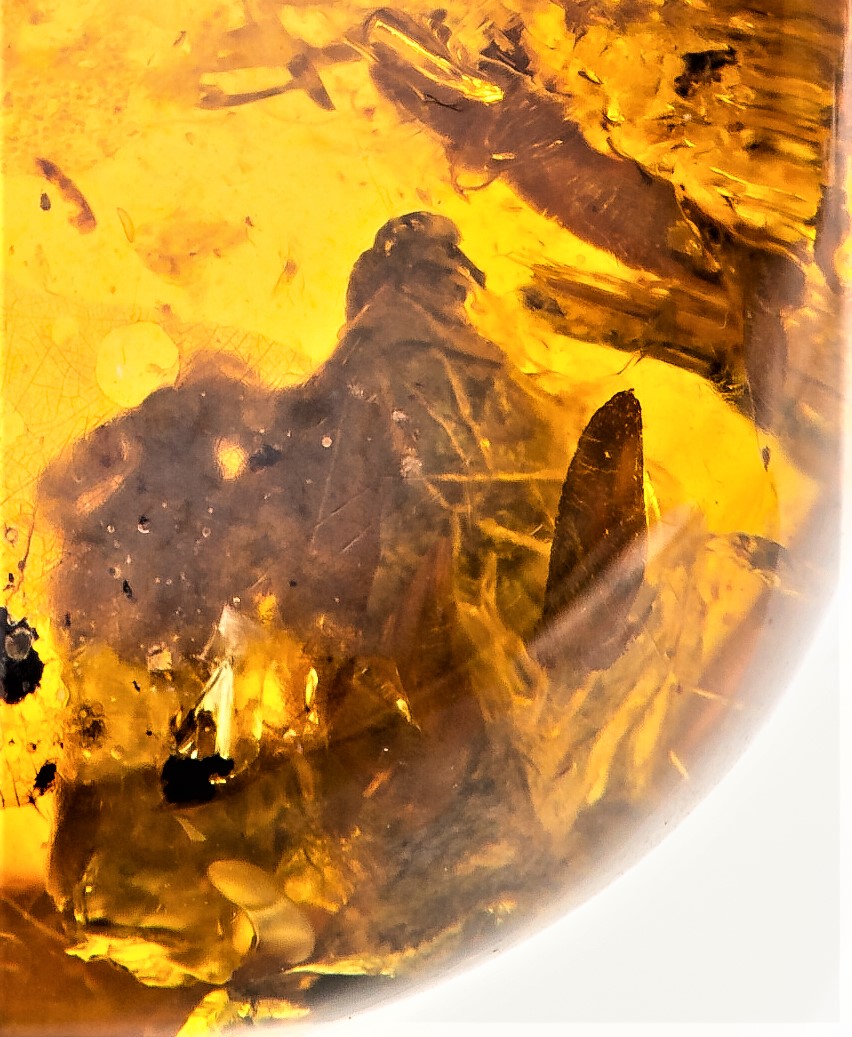Pterosaurs in amber
The pterosaur in the picture below is from a historically controversial piece of amber that was first acquired in the belief that it was a tiny enanthiornithine in amber. There are feathers present and visible on both the tiny bird named Romeo and his parents who are partially present in the amber above him. The first confirmations that it is a pterosaur came from Professor Meehan's micro ct renderings which also helped us understand the mother/father role in this scene. If you look carefully at Romeo in the picture below you will see that underneath him are the bones of the fingers of the wing claw of a parent bird that perhaps was trying to save Romeo from the amber. Amber flows suggest that the amber probablty caught Romeo in a tree hollow and that the parents could not bring him out quickly enough, on the surface of the amber you can see the clear venation of a fossil leaf on the surface of the amber. The leaf was not removed from the amber as it is already sad in many cases that amber specimens are ground down and have windows created to help assist clearer viewing of important inclusions within.

This work is licensed under a Creative Commons Attribution 4.0 International License.
Here is an example, this pterosaur is the most common pterosaur in Burmite and specimens come in numerous sizes and social interaction groups in amber.
- To view micro-CT data on this volant CLICK HERE
- To learn about an extroadinarily large similar volant creature CLICK HERE
- To view photos of "scaly" volant in the same piece of amber CLICK HERE
- To view micro-CT data on scaly volant CLICK HERE
- Click here if you would like to see Hi Res image of the "front" side of the Romeo in amber showing mother's head, wingbone, claw and feathers
- Click here if you would like to see Hi Res image of the "reverse" side of the Romeo small pterosaur in amber
- Click here if you would like to see Hi Res image of the "close-up" side of the Romeo in amber
- Click here if you would like to see Hi Rehi res stacked micrograph of the Romeo's head with scale
- Click here if you would like to see UV light imaging with fluorescence of pterosaur adult in amber (Romeo's father)
- Click here if you would like to see teeth images from large pterosaur head without fluorescence.
- Click here if you would like to see teeth images from large pterosaur head using fluorescence.
- Click here to see hi-resolution SIDEVIEW of entire head that you can download and zoom in on
- Click here to see hi resolution entire TOPVIEW without fluorescence.
- Click here to see full stacked and stitched trial run of Romeo the small anurognathid pterosaur in amber
- 3dimensional video spinarounds, render slices etc (Romeo).
nano-imaging is continually in progress and should you need updates please contact us
pterossauro em âmbar pterosaur ni Amber PTEROSAUR NA AMBER PTEROSAUR IN AMBER פּטעראָסאַור אין בורשטין pterosaur mewn ambr pterosaur trong hổ phách امبر میں پتروساس ПЕРЕХОДА В ЯНТАРЕ 앰버에있는 범인 アンペア PTEROSAUR I AMBER एम्बर में पेंटोसॉर פטרוזאור בענבר PTEROSAUR EN AMBRE 龙之王 龍之王 มังกรในอำพัน ፖርዮሰርቶ በበርበሪ التيروصور، إلى داخل، العنبر pterosaur në qelibar




